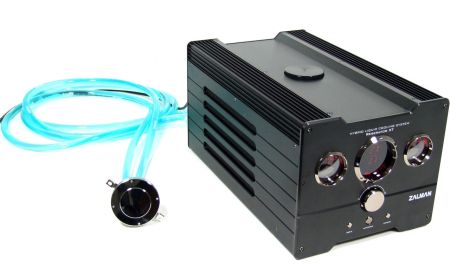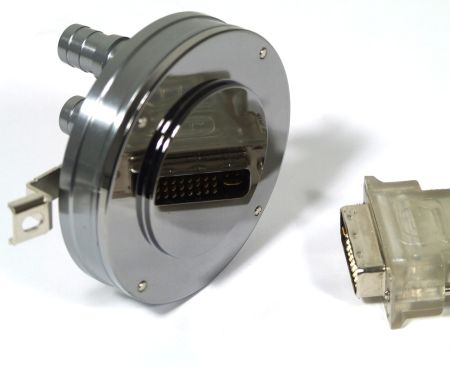CPU Cooler Charts 2008, Part 2
Zalman Reserator XT - Heavy And Expensive
Zalman Reserator XT
The Reserator XT water cooling solution is the second product made by Zalman to be featured in this part of the cooler roundup. Its name is a blend of the words "reservoir" and "radiator", denoting that these two components form a single unit.
The Reserator XT is the fourth version of Zalman's external water cooler series, the first generation to sport active cooling of the radiator. Previous models had either been designed as passive coolers, or only featured an optional fan upgrade.
In order to fill the reservoir, you'll need to attach the so-called "degussing tube", a short length of tubing that makes it easier to get residual air out of the radiator. Filling the cooler and its circulation with water is much easier than on the Reserator 2. Simply switch on the unit and the water will begin circulating straight away, without requiring you to tilt or pivot the heavy cooler. It looks like Zalman did its homework on this point.
Not an optimal solution - a wire switches on the power supply
That notwithstanding, we still have a few critical remarks. First, in order for the cooler to be operational, it has to be hooked up to the computer's power supply. Since the computer can't be running at this point, the power supply has to be switched on manually, but Zalman only includes a short wire with its cooler for this purpose. Connecting it to the wrong pins of the ATX power cable can easily damage the power supply. A conventional power adapter would have been a much better choice here.
A view from the side - the flow control on the left, the radiator in the middle
Get Tom's Hardware's best news and in-depth reviews, straight to your inbox.
You should also be very careful when removing the connector from the short "degussing tube" when you attach the cooler's tube to close the cooling circuit, or you may quickly find blue anti-corrosion liquid all over your clothes. (We speak from experience here.) The connectors are drip-proof, though, meaning you can simply disconnect the cooler when transporting it.
If the computer's hardware configuration changed in such a way that it requires the water cooler's slot bracket on the back of the case to be removed, you'll also be forced to detach the tubes leading to the CPU cooling block - which also means draining all of the water from the cooling system.
CPU cooler with tubes attached
The contact surface of the CPU cooler
The water block is mounted using the familiar retention modules used by Zalman. To do so, the motherboard has to be removed for the first installation. Luckily, if you're only swapping out CPUs, all you have to do is release two screws to take off the cooler.
The huge retail box of Zalman's Reserator XT
Current page: Zalman Reserator XT - Heavy And Expensive
Prev Page Cooler Master Hyper TX2 - A Very Cool Bargain Next Page Zalman Reserator XT (Cont'd.)-
Great article, but it mentions testing over 80 coolers - but I see only about 15 in the test charts. Where, for example, is the Tuniq Tower T120??Reply
Thanks.





